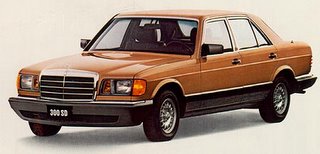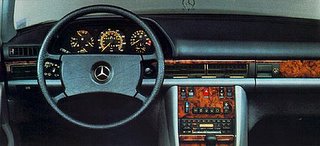
In the 1970s, the OPEC induced gas crisis led to a rush importation of German diesel cars in the United States. The fuel crunch inspired Mercedes-Benz to implement turbo-diesel models in their flagship S-Class saloons.
The 300SD was first produced in the W116 series (1972-1980).

The 70s S-Class was something of a low profile tank and at over 4,000 lbs the original 300SD was lethargic in its performance. The 1980s changed that by shaving the pounds off the less hefty and more aerodynamic W126 series (1979-1991). The new 300SD felt as solid as a tank, but at roughly 3,700 lbs weighted considerably less than one. Hence, acceleration was better, as was fuel range.
Looking back on the 300SD, I remember liking the car.
I have never experienced a new or even lightly used 300SD; which says something about the condition of those cars today (and my age). Most of the early W126 S-Class turbo-diesels continue to be used hard as veritable work horses and many have accrued over 300,000 miles. In these terms, it is difficult to consider most 300SDs today as luxury cars.
There is no question, however, that in the 1980s the 300SD was the gold standard.
The MSRP for a 1983 Mercedes-Benz 300SD was $38,500; or 73,542 in today’s dollars.
There was no finer diesel car on the road. As an S-Class sedan, the 300SD represented the penultimate in luxury automotive transportation.
By contemporary standards, a new 300SD was quiet at cruising speed, smooth in the dispatch of broken asphalt, comfortably spacious for the front passengers, and relatively so for the rear. Above all, the turbo-diesel sedan enjoyed that sterling accolade of most pre-2000 Benzes in that the car felt as secure as a “bank vault”.
This S-Class was not without its foibles though.
Anti-lock brakes (ABS) were not standard equipment. There was no option of having a self-leveling suspension system. These two assets would have been key in everyday performance terms as I will explain. 15” rather than 14” wheels would have benefited handling and braking as well.
There were no memory controls for the power front seats; the front headrests were manually adjustable, there were no rear headrests. Fixed in its position; the hub of the steering wheel was hard plastic, the rim trimmed in vinyl (“leatherette” in Benz lexicon); and most 300SDs were fitted with the often cold and ill-matched Zebrano wood trim.
On highway and what I affectionately refer to as The Test Track- a twisting hilly road that cuts through a bucolic forest reserve, free of population and traffic, full of undulations, sudden drops, and a quarter mile straightaway– I had the fine opportunity to drive on different occasions two 300SDs in the late 1990s.
I shall report on my experiences in The Drive.

No comments:
Post a Comment